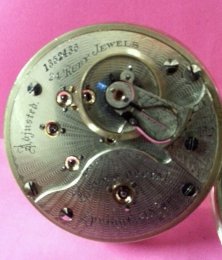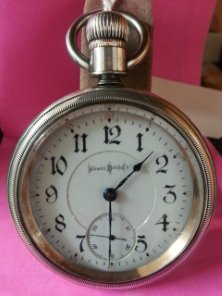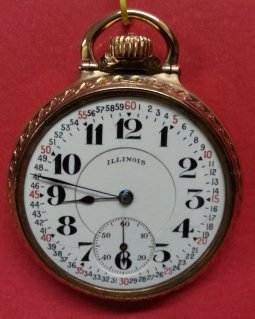Illinois Watch Company
The Illinois Watch Company was first established in December 1869 as the Springfield Watch Company by John C. Adams of Massachusetts, and John Todd Stuart, William B. Miller, Dr. George Pasfield, John Whitfield Bunn, John Williams, and George N. Black, all of Springfield, Illinois. John Todd Stuart, former Congressman and early law partner of Abraham Lincoln, served as the first President of the new corporation. Construction of a factory just outside Springfield began in December 1869.
The first watches were completed in January 1872. These models were made by D. G. Currier and J. K. Bigalow, and were 18 size, full plate, key wind. They were called the Stuart, Bunn, Miller,Currier, Hoyt and Mason. By the end of 1872, the corporation had sold approximately 10,000 watch movements.
In July 1877 the corporation was reorganized and changed its name to the Illinois Springfield Watch Company, Erastus Newton Bates served as President of the corporation.
The Illinois Springfield Watch Company was reorganized in the autumn of 1878, and was renamed the Illinois Watch Company. Chief executive leadership of the corporation was assumed by Jacob Bunn, Sr., an Illinois industrialist, railroad financier, railroad reorganizer, wholesale grocer, commission merchant, newspaper publisher, land developer, coal operator, political advisor and financier, banker, and rope manufacturer.
Under Jacob Bunn, Sr., corporate employment grew from 260 in 1879, to 400 in 1880. In 1879, the corporation manufactured 33,285 watch movements. In 1880, the corporation manufactured 47,065 watch movements. In 1897 Jacob Bunn, Jr. became President, holding the position until his death in 1926.
The first group of 100 watches produced were 18-size, 15-jewel, full plate, key wind, adjusted Stuart railroad grade watches in 1872. The Bunn family surname was used on Illinois’ most famous railroad watch grades, starting with the first 18-size, 15-jewel, adjusted Illinois Bunn movements introduced with serial number 201.
The 18-size, 15-jewel, full plate, key wind, adjusted Millermovements were also advertised as having “a good reputation with Railroad Men”. All three grades were available adjusted to temperature and isochronism, with “adjusted” engraved on the balance bridge.
The first stem-wind, hunting case watch, the Model 2, was produced in 1875. The stem-winding Model 2 Stuart, Bunn and Miller grades were manufactured for railroad time service starting in 1878. The open face, stem-wind Model 3 was introduced in 1879, with the Stuart,Bunn and Miller grades manufactured for railroad time service.
In 1891 a new Bunn movement was introduced with 16-jewels. In 1895 – 1896, Illinois introduced the 18-size, 21-jewel Bunn Special and 24-jewel Bunn Special grade watches, both were available as open face (model 6) and hunting case (model 5) and were adjusted to temperature, isochronism and positions. The Bunn grade was 17-jewels, also adjusted to temperature, isochronism and positions. The adjusted Stuart and Miller grades were discontinued.
18 size Illinois Bunn special 24 jewels Dates to 1899


16-size Watches Manufactured for Railroad Service
Illinois began producing the smaller 16-size watches suitable for railway service with the introduction of the 16-jewel grade No. 116 around 1888. The Sangamo became Illinois premier 16-size, 21-jewel, and 23-jewel grade movement around 1899, it was intended for the railroad market from its inception.
An advertisement in The Railway Conductor in 1903 stated the Sangamo watches “are good strong durable watches and are designed especially for railroad service where accurate time is an absolute necessity.”
16 Size Illinois Bunn Special

The Sangamo Special was introduced in 1913, available in 19 – jewel, 21 jewel and 23 jewel versions. In 1913, the 16 size, 21 – jewel and 23 Jewel Bunn Special grades andthe 17 jewel and 19 jewel Bunn grades wee also introduced.
Introduced in 1907, the 18-size 21-jewel and 16-size 21-jewel A. Lincoln grades were also widely used in railroad service.
In 1903, the Illinois Watch Company stopped producing its lowest priced watches, focusing on producing moderate priced watches and high grade watches to meet the exacting requirements of railroad service. At its peak, the Illinois Watch Company employed approximately 1,200 people.
Jacob Bunn, Jr. passed on in 1926. In 1928, for a sum in excess of $5,000,000, the Illinois Watch Company was purchased by the Hamilton Watch Company, which continued to operate the factory under the Illinois name and shifted the emphasis from pocket to wrist watch production. The Illinois Watch Company had turned out about five million watches before being sold to the Hamilton Watch Company. By 1932, the Great Depression forced Hamilton to close the Illinois factory, though they retained possession of the brand name.
In the 1950’s, Hamilton offered a line of Illinois and Hamilton-Illinois wrist watches with Swiss movements. These have absolutely nothing in common with the watches produced by the original Illinois Watch Company except the name.
Contract Watches
The Illinois Watch Company also produced watches under contract for several different brands, including the Burlington Watch Company (Chicago, Illinois), whose line included high quality 19-jewel and 21-jewel railroad grade watches; the Santa Fe Watch Company (Topeka, Kansas), whose line included the 21-jewel Santa Fe Special railroad grade watch also sold mail order; the Paillard Non-Magnetic Watch Company (Chicago, Illinois), whose line included high quality 17-jewel and 21-jewel railroad grade watches, the Plymouth Watch Company (Sears Roebuck), and the Washington Watch Company (Montgomery Ward).
| Illinois railroad grade watches (not all were railroad approved)
The following is from list of railroad grade watches which is generally attributed Webb C. Ball. Not all of these were railroad approved even though all are railroad grade.
|
Illinois Watch Case Company
NOTE: The Illinois Watch Company should not be confused with the Illinois Watch Case Company of Elgin, Illinois. The Illinois Watch Case Company was a major manufacture in the city of Elgin, Illinois. It manufactured watch cases under many brands, such as “Elgin Giant”, “Elgin Pride”, “Tivoli”, “Spartan”, and “Elgin Commander”.
The use of the name “Elgin” in their brand names, or marking the cases with “Elgin USA” has often lead people to believe that a watch was made by the Elgin National Watch Company when it was actually made by another manufacturer, or to think that a watch no longer has its original case because it is “now in an Elgin case”.
Illinois Watch Company
Illinois Watch Serial Numbers and Production Dates
| Year | S/N | Year | S/N | Year | S/N |
| 1872 | 5,000 | 1893 | 1,200,000 | 1914 | 2,600,000 |
| 1873 | 20,000 | 1894 | 1,600,000 | 1915 | 2,700,000 |
| 1874 | 50,000 | 1895 | 1,220,000 | 1916 | 2,800,000 |
| 1875 | 75,000 | 1896 | 1,250,000 | 1917 | 3,000,000 |
| 1876 | 100,000 | 1897 | 1,290,000 | 1918 | 3,200,000 |
| 1877 | 145,000 | 1898 | 1,330,000 | 1919 | 3,400,000 |
| 1878 | 210,000 | 1899 | 1,370,000 | 1920 | 3,600,000 |
| 1879 | 250,000 | 1900 | 1,410,000 | 1921 | 3,750,000 |
| 1880 | 300,000 | 1901 | 1,450,000 | 1922 | 3,900,000 |
| 1881 | 350,000 | 1902 | 1,500,000 | 1923 | 4,000,000 |
| 1882 | 400,000 | 1903 | 1,650,000 | 1924 | 4,500,000 |
| 1883 | 450,000 | 1904 | 1,700,000 | 1925 | 4,700,000 |
| 1884 | 500,000 | 1905 | 1,800,000 | 1926 | 4,800,000 |
| 1885 | 550,000 | 1906 | 1,840,000 | 1927 | 5,000,000 |
| 1886 | 600,000 | 1907 | 1,900,000 | -Sold | To Hamilton- |
| 1887 | 700,000 | 1908 | 2,100,000 | 1928 | 5,100,000 |
| 1888 | 800,000 | 1909 | 2,150,000 | 1929 | 5,200,000 |
| 1889 | 900,000 | 1910 | 2,200,000 | 1931 | 5,400,000 |
| 1890 | 1,000,000 | 1911 | 2,300,000 | 1934 | 5,500,000 |
| 1891 | 1,040,000 | 1912 | 2,400,000 | 1948 | 5,600,000 |
| 1892 | 1,080,000 | 1913 | 2,500,000 | – | – |
See our services on how we can carefully restore vintage timepieces to their former glory.
